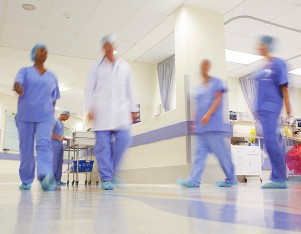On April 24th, the President signed into law the Paycheck Protection Program and Health Care Enhancement Act (commonly referred to as “COVID 3.5”). COVID 3.5 supports small businesses by providing additional funding for the Payroll Protection Program and Disaster Loans Program established under the Coronavirus Aid, Relief, and Economic Security Act. COVID 3.5 also provides grant funding of $75 billion for health care providers to address COVID-19 expenses and revenue shortfalls and $25 billion (including $11 billion specifically dedicated to state and local governments) for testing. This blog will focus on the latter provisions of COVID 3.5.
Funding for COVID-19 Expenses and Revenue Shortfalls
COVID 3.5 appropriates $75 billion for the Public Health and Social Services Emergency Fund[1] to support eligible health care providers affected by the simultaneous costs associated with addressing COVID-19 and the revenue declines associated with postponing elective procedures.[2] Eligible health care providers receiving such funds are subject to the following restrictions:
- Eligible health care providers must have a valid tax identification number and are required to submit an application including a statement justifying the need for such funds;
- Funds may not be used to reimburse expenses or losses that have been reimbursed from other sources or for which other sources are obligated for such reimbursement;
- Eligible health care providers must submit reports and maintain documentation as required by the Secretary of Health and Human Services (“HHS”) to ensure compliance with such conditions; and
- Permitted uses of funds include the building or construction of temporary structures, leasing of properties, medical supplies and equipment including personal protective equipment and testing supplies, increased workforce and trainings, emergency operation centers, retrofitting facilities and surge capacity.
Funding for COVID-19 Testing
COVID 3.5 appropriates $25 billion to the Public Health and Social Services Emergency Fund for necessary expenses to research, develop, validate, manufacture, purchase, administer and expand capacity for COVID-19 testing as follows:
- Not less than $11 billion for state and local governments for necessary expenses to develop, purchase, administer, process, and analyze COVID–19 tests, including support for workforce; epidemiology; use by employers or in other settings; scale-up of testing by public health, academic, commercial, and hospital laboratories, and community-based testing sites, health care facilities, and other entities engaged in COVID–19 testing; conduct surveillance; trace contacts; and other related activities related to COVID–19 testing.
- A portion of this amount will be allocated to state and local governments according to a formula methodology to be developed by the HHS Secretary based on relative number of cases of COVID–19.
- Recipients must submit a COVID-19 testing plan to the HHS Secretary no later than 30 days after the date of enactment of COVID 3.5, including goals for the remainder of calendar year 2020, including: (i) the number of tests needed, month-by-month; (ii) month-by-month estimates of laboratory and testing capacity; and (iii) a description of how the recipient will use its resources for testing, including as it relates to easing any COVID–19 community mitigation policies.
- Funds must be distributed no later than 30 days after the enactment of COVID 3.5.
- Not less than $1 billion to the Centers for Disease Control for surveillance; epidemiology; laboratory capacity expansion; contact tracing; public health data surveillance and analytics infrastructure modernization; disseminating information about testing; and workforce support necessary to expand and improve COVID–19 testing.
- To the National Institutes of Health, (a) not less than $306 million to the National Cancer Institute to develop, validate, improve, and implement serological testing and associated technologies; (b) not less than $500 million to the National Institute of Biomedical Imaging and Bioengineering to accelerate research, development, and implementation of point of care and other rapid testing related to coronavirus which, as defined in COVID 3.5, includes SARS–CoV–2 and other coronaviruses with pandemic potential; and (c) not less than $1 billion to the Office of the Director: (i) to develop, validate, improve, and implement testing and associated technologies; (ii) to accelerate research, development, and implementation of point of care and other rapid testing; and (iii) for partnerships with governmental and non-governmental entities to research, develop, and implement such activities.
- Not less than $1 billion to the Biomedical Advanced Research and Development Authority for necessary expenses of advanced research, development, manufacturing, production, and the purchase of diagnostic, serologic, or other COVID–19 tests or related supplies, and other activities related to COVID–19 testing at the discretion of the HHS Secretary.
- $22 million to the Food and Drug Administration to support activities associated with diagnostic, serological, antigen, and other tests, and related administrative activities.
- $600 million to the Health Resources and Services Administration for grants to: (a) qualifying health centers under the Health Center Program, as defined by section 330 of the Public Health Service Act, and (b) federally qualified health centers, as defined in section 1861(aa)(4)(B) of the Social Security Act, to provide health care services to medically underserved populations.
- $225 million to rural health clinics (as defined in section 1861(aa)(2) of the Social Security Act) to provide additional funding for COVID–19 testing and related expenses, including building or construction of temporary structures, leasing of properties, and retrofitting facilities as necessary to support COVID–19 testing.
- Up to $1 billion may be used to cover the cost of testing for the uninsured.
Under COVID 3.5, permitted uses for the $25 billion appropriated for testing include: (a) the rent, lease, purchase, acquisition, construction, alteration, renovation, or equipping of non-federally owned facilities to improve preparedness and response capability at the state and local level for diagnostic, serologic, or other COVID–19 tests, or related supplies; (b) the construction, alteration, renovation, or equipping of non-federally owned facilities for the production of diagnostic, serologic, or other COVID–19 tests, or related supplies, where the Secretary determines that such a contract is necessary to secure or produce sufficient amounts of such tests or related supplies; or (c)(i) the purchase of medical supplies and equipment, including personal protective equipment and testing supplies to be used for administering tests; (ii) increased workforce and trainings, emergency operation centers, and surge capacity for diagnostic, serologic, or other COVID–19 tests; or (iii) related supplies.
If you have any questions regarding the resources available to health care providers and state and local governments under COVID 3.5, please contact Neal Pandozzi at npandozzi@apslaw.com.
[1] The Public Health and Social Services Emergency Fund is administered by the Department of Health and Human Services.
[2] “Eligible health care providers” means public entities, Medicare or Medicaid enrolled suppliers and providers, and such for-profit entities and not-for-profit entities as the Secretary may specify, within the United States (including territories), that provide diagnoses, testing or care for individuals with possible or actual cases of COVID-19.





